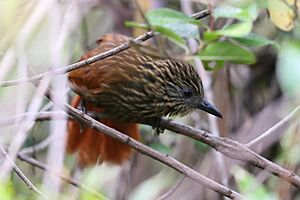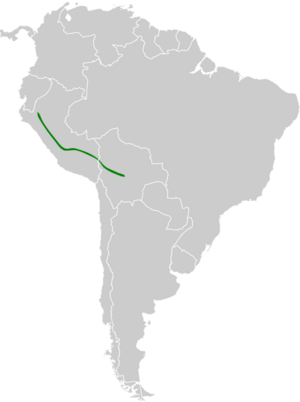Peruvian treehunter facts for kids
Quick facts for kids Peruvian treehunter |
|
|---|---|
 |
|
| Conservation status | |
| Scientific classification | |
| Genus: |
Thripadectes
|
| Species: |
scrutator
|
 |
|
The Peruvian treehunter (Thripadectes scrutator) is a cool bird that lives in the forests of South America. It's part of the ovenbird family called Furnariidae. These birds are known for building interesting nests. You can find this bird in countries like Bolivia and Peru. Sometimes, people also call it the rufous-backed treehunter or the buff-throated treehunter because of its colors.
Contents
Bird Family and Relatives
The Peruvian treehunter is closely related to two other types of treehunters. These are the uniform treehunter and the flammulated treehunter. You can think of them as close cousins in the bird world!
This bird is considered "monotypic." This means that scientists currently recognize only one main type of Peruvian treehunter. Even though some birds in the southern parts of their home range look a bit more reddish, they are still the same species.
What Does It Look Like?
The Peruvian treehunter is a medium-sized bird. It is about 23 to 24 centimeters (9 to 9.5 inches) long. It weighs around 56 to 61 grams (about 2 ounces). This bird is quite strong and has a thick beak.
Both male and female Peruvian treehunters look the same. Their faces are dark, almost blackish, with clear buff-colored streaks. The area around their eyes is dark with buff speckles. Their head, neck, and upper back are dark with wide, blurry buff streaks. These streaks fade as you look further down their back.
Their lower back is a rich brown color with faint reddish streaks. These streaks blend into their dark reddish-brown rump. The feathers covering their tail are chestnut-colored. Their wing feathers are also chestnut, and their flight feathers are a pale reddish-brown. Their tail is chestnut-colored too.
Their throat and chest are dark with buff streaks. These streaks are strongest on their upper chest. Their lower chest, belly, and sides are brownish with faint buff streaks that fade out. The feathers under their tail are reddish-brown. Their eyes are brown, their beak is black, and their legs and feet are gray to brown.
Where It Lives and Its Home
The Peruvian treehunter lives along the eastern side of the Andes mountains. You can find it from northern Peru, specifically the Department of Amazonas, all the way south and east of the Marañón River into Bolivia. It goes as far as the Cochabamba Department.
This bird makes its home in high-elevation cloudforests and elfin forests. These are very humid places. It especially likes areas with large, thick patches of Chusquea bamboo. You can find them at elevations from 2,450 to 3,500 meters (about 8,000 to 11,500 feet) above sea level.
Behavior
Movement
The Peruvian treehunter stays in the same area all year long. It does not migrate to different places.
Feeding Habits
Peruvian treehunters eat small creatures like arthropods (like insects and spiders), molluscs (like snails), and even tiny vertebrates (small animals with backbones).
They usually look for food in thick plants close to the ground, often within 2 meters (about 6.5 feet) of the forest floor. They usually forage alone, but sometimes you might see a pair together. They rarely join groups of different bird species that are feeding together. Scientists believe they find food by poking and picking at moss and leaves along bamboo stalks, tree branches, and trunks.
Reproduction
Scientists think that Peruvian treehunters are monogamous. This means a male and female bird likely stay together as a pair for breeding. However, not much else is known about how they raise their young.
Vocalization
The song of the Peruvian treehunter is a loud, rattling sound. It's a fast series of notes that go up and down in pitch, getting faster and then slower. It sounds like tchu-tchu-tchu-tchu’TCHI’TCHI’TCHI’TCHI’TCHI’TCHI’ tchu’tchu-tchu-tchu-tchu. Its call is a sharp, loud TCHIK.
Conservation Status
The IUCN (International Union for Conservation of Nature) has evaluated the Peruvian treehunter. They have listed it as a species of "Least Concern." This means that, for now, it is not considered to be in immediate danger of disappearing.
The bird lives across a large area, and its total population size is not known. However, scientists believe the population is stable. No immediate threats have been found. It's a species that isn't very well-known and seems to be spread out thinly across its habitat.
Even though it's "Least Concern," its habitat is being cleared and broken up at a fast rate. The effects of these human activities on the Peruvian treehunter's population are still unknown.


